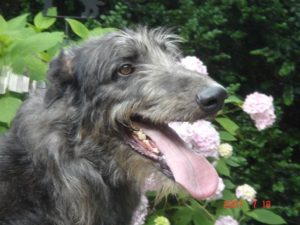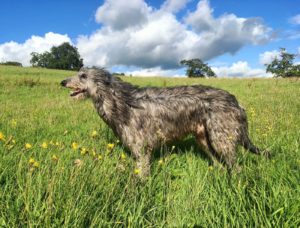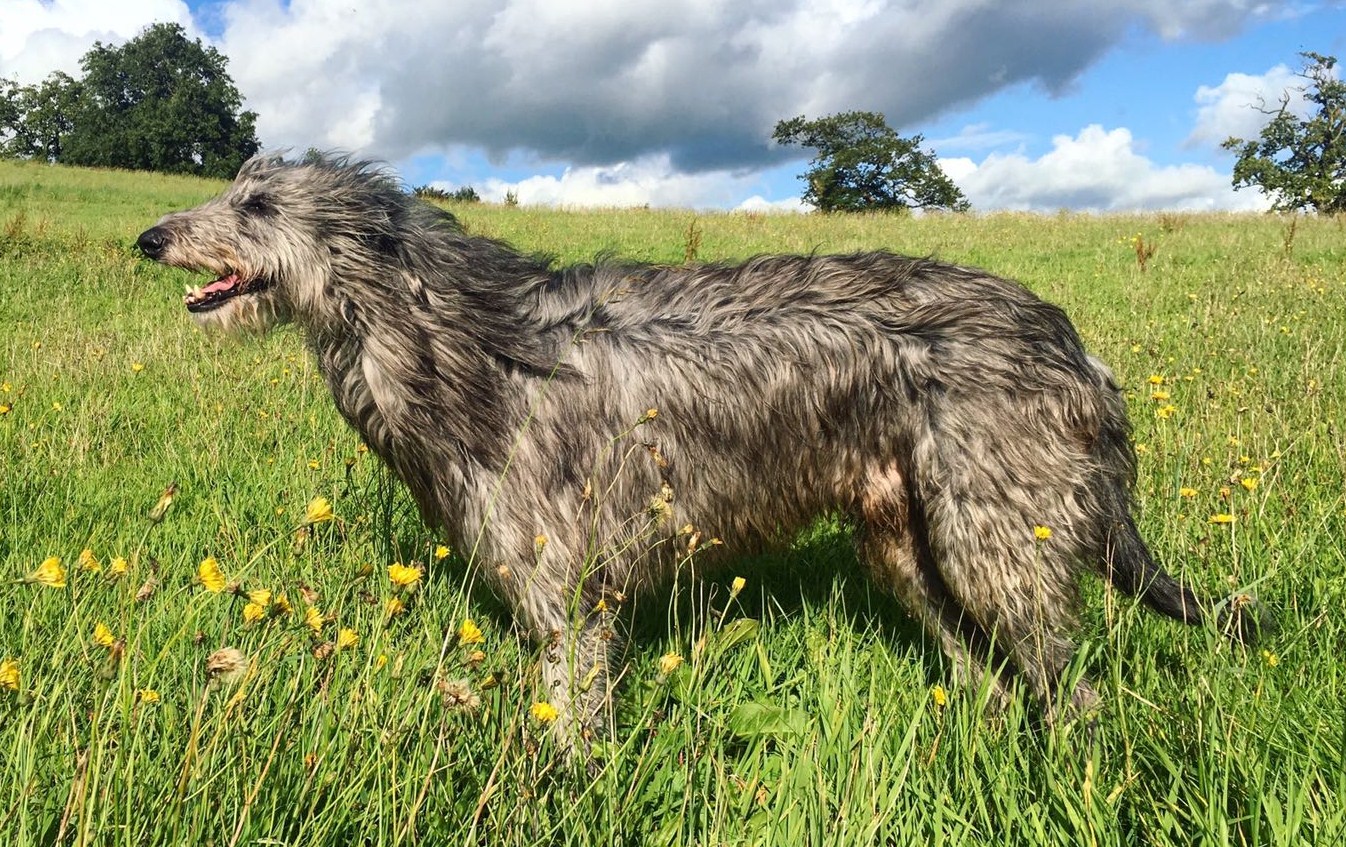17 May 2018
Dog Aggression
Who’s to blame?
By Lynda Goetz
 Last week, both The Times and The Telegraph carried a picture of an attractive young blonde woman cradling a pop-eyed Chihuahua with headlines to the effect that the poor creature had been attacked by an ‘out-of-control’ hound owned (would you believe!) by a Cruft’s judge, one Mrs Wragg. Reading the articles (The Telegraph gave the incident more coverage and a much larger, although identical photo) it appeared that the young woman, Ella Tramonte, had reported to police an incident which occurred between 1.25pm and 1.35pm on April 20 at Mottisfont Abbey. The ‘incident’ in question was a ‘fracas’ between Miss Tramonte’s pooch, Rolo, and a pair of deerhounds (who interestingly remained un-named and anonymous in the report), one of which had picked up the smaller dog in its mouth. Poor little Rolo had sustained a puncture wound, which required emergency veterinary attention, and Mrs Wragg, “mortified” by her dog’s behaviour, had agreed to pay the £314.55 vet bill. There, one would have thought, the matter should have ended. Why were we reading about it in the national press?
Last week, both The Times and The Telegraph carried a picture of an attractive young blonde woman cradling a pop-eyed Chihuahua with headlines to the effect that the poor creature had been attacked by an ‘out-of-control’ hound owned (would you believe!) by a Cruft’s judge, one Mrs Wragg. Reading the articles (The Telegraph gave the incident more coverage and a much larger, although identical photo) it appeared that the young woman, Ella Tramonte, had reported to police an incident which occurred between 1.25pm and 1.35pm on April 20 at Mottisfont Abbey. The ‘incident’ in question was a ‘fracas’ between Miss Tramonte’s pooch, Rolo, and a pair of deerhounds (who interestingly remained un-named and anonymous in the report), one of which had picked up the smaller dog in its mouth. Poor little Rolo had sustained a puncture wound, which required emergency veterinary attention, and Mrs Wragg, “mortified” by her dog’s behaviour, had agreed to pay the £314.55 vet bill. There, one would have thought, the matter should have ended. Why were we reading about it in the national press?
 Scottish Deerhounds are large dogs, about the size of a baby donkey. Historically they were only allowed to be owned by royalty or members of the aristocracy (on the whole, given their size, those without land, a castle and a large hearth in front of which to accommodate them would find them fairly impractical to own anyway). They were bred, as the name suggests, to hunt and bring down deer. However, they have intrinsically gentle natures and had to be trained to kill. Should you look them up (e.g. under the excellent site Your Pure Bred Puppy) they are described as ‘amiable with other dogs’ but ‘serious chasers of anything that runs, including cats and tiny dogs’. Wikipedia describes them as ‘Docile, Gentle, Dignified, Friendly’.
Scottish Deerhounds are large dogs, about the size of a baby donkey. Historically they were only allowed to be owned by royalty or members of the aristocracy (on the whole, given their size, those without land, a castle and a large hearth in front of which to accommodate them would find them fairly impractical to own anyway). They were bred, as the name suggests, to hunt and bring down deer. However, they have intrinsically gentle natures and had to be trained to kill. Should you look them up (e.g. under the excellent site Your Pure Bred Puppy) they are described as ‘amiable with other dogs’ but ‘serious chasers of anything that runs, including cats and tiny dogs’. Wikipedia describes them as ‘Docile, Gentle, Dignified, Friendly’.
 Chihuahuas on the other hand are one of the smallest breeds of dog and have very variable personalities as described by Your Dog Advisor. Although they can make good family pets, they can also be over-protective of their owners and suffer from ‘small dog syndrome’ – a nice way of saying they can be aggressive with a tendency to growl, yap or snap, particularly when faced with a larger dog. Rolo was faced with two larger dogs, two very much larger dogs. To his loyal mind, his young mistress might have been in danger. His defensive-aggressive reactions almost certainly came to the fore. One does not learn if Rolo was on a lead, but Miss Tramonte, who herself may or may not be an experienced dog owner, was very critical of Mrs Wragg. “An experienced dog handler should not be allowing their animals to pull them along. I would never have taken one of those dogs out, let alone both,” she sniffed. Miss Tramonte, like so many owners of small dogs, appears to assume that ‘those dogs’, perhaps because of their size and strength, would be aggressive, whereas in fact the opposite is true.
Chihuahuas on the other hand are one of the smallest breeds of dog and have very variable personalities as described by Your Dog Advisor. Although they can make good family pets, they can also be over-protective of their owners and suffer from ‘small dog syndrome’ – a nice way of saying they can be aggressive with a tendency to growl, yap or snap, particularly when faced with a larger dog. Rolo was faced with two larger dogs, two very much larger dogs. To his loyal mind, his young mistress might have been in danger. His defensive-aggressive reactions almost certainly came to the fore. One does not learn if Rolo was on a lead, but Miss Tramonte, who herself may or may not be an experienced dog owner, was very critical of Mrs Wragg. “An experienced dog handler should not be allowing their animals to pull them along. I would never have taken one of those dogs out, let alone both,” she sniffed. Miss Tramonte, like so many owners of small dogs, appears to assume that ‘those dogs’, perhaps because of their size and strength, would be aggressive, whereas in fact the opposite is true.
Although no details of the incident are really given, there are various possible scenarios. They all involve dog behaviour, and dog communication, not all of which is understood by humans. The chihuahua’s reactions may well have incited the deerhounds. Effectively he could have been swearing at them in ‘dog’. The deerhounds may simply have wanted to follow their instincts and chase. The panic of Rolo’s owner and partner could have contributed to the heat of the situation. Whatever the actual facts were, it is indisputable that had the deerhound really intended to kill the Chihuahua it would have done so long before 10 minutes had elapsed. They have immensely powerful jaws which can break bones larger than a Chihuahua’s without any difficulty. Had the deerhound not wanted to let go of his ‘victim’, Miss Tramonte’s boyfriend, Elliot Hills, would have had serious difficulty prising open his mouth to free the dog as was claimed he had to do. This rather trivial little tale (distressing as it would have been for all parties concerned) does however illustrate some of the problems with modern dog ownership.
In the April 30 edition of the Veterinary Times, the front page article highlights the concerns of one of the leading pet insurers on the ‘increasing humanisation of pets’. More Than’s study on ‘The Future of Pet Ownership’ links behavioural problems, obesity and the rise of designer breeds to the growing trend of anthropomorphism. ‘Anthropomorphism’, or the attribution of human characteristics to animals, means that people are failing to understand how their pets’ minds really work. This is leading to a lack of proper training and discipline (although some may consider that is not limited to people’s pets!) and also to poor nutritional choices (“but my dog loves chips!”) as well as the creation of animals with a desired ‘look’.
Many people choose pets without serious consideration of the commitment and expense they are going to incur as a result of ownership. Not only is there the time involved, but also the expense. As the More Than survey showed, 40 per cent of dogs and 70 percent of cats are uninsured. Without insurance many people are unable to pay vet bills and, partly because of the ‘free at the point of delivery’ model of the NHS, they have no idea of the costs of medications, procedures and treatments. This can result in vets being told to put down otherwise perfectly healthy animals because that is cheaper than the costs of treatment. Not surprisingly vets find this extremely distressing. The alternative (which frequently happens) is that vets feel obliged to treat the animal at their own expense and then rehome it. (Kind-hearted vet nurses often own several re-homed animals).
 The characteristics of the animal which one is going to acquire are also important. Different dog breeds vary greatly in size and physical appearance, but they also behave very differently. If you are looking for a family pet it is almost certainly unwise to choose a working dog such as a Border Collie. His very intelligence and need to work make him unsuitable for most families. A small Yorkshire terrier may be equally problematic for very different reasons (including his fragility – the problems of children’s rough and tumble or the fact that a larger dog could kill him with one quick shake). Owning an Akita could well put you in the way of the legal liabilities which it appears poor Mrs Wragg may be about to be subjected to as a result of Miss Tramonte’s complaints. Personally I suspect that Rolo, snuggled and alert in his owner’s arms in his padded coat, was probably smirking quietly.
The characteristics of the animal which one is going to acquire are also important. Different dog breeds vary greatly in size and physical appearance, but they also behave very differently. If you are looking for a family pet it is almost certainly unwise to choose a working dog such as a Border Collie. His very intelligence and need to work make him unsuitable for most families. A small Yorkshire terrier may be equally problematic for very different reasons (including his fragility – the problems of children’s rough and tumble or the fact that a larger dog could kill him with one quick shake). Owning an Akita could well put you in the way of the legal liabilities which it appears poor Mrs Wragg may be about to be subjected to as a result of Miss Tramonte’s complaints. Personally I suspect that Rolo, snuggled and alert in his owner’s arms in his padded coat, was probably smirking quietly.


